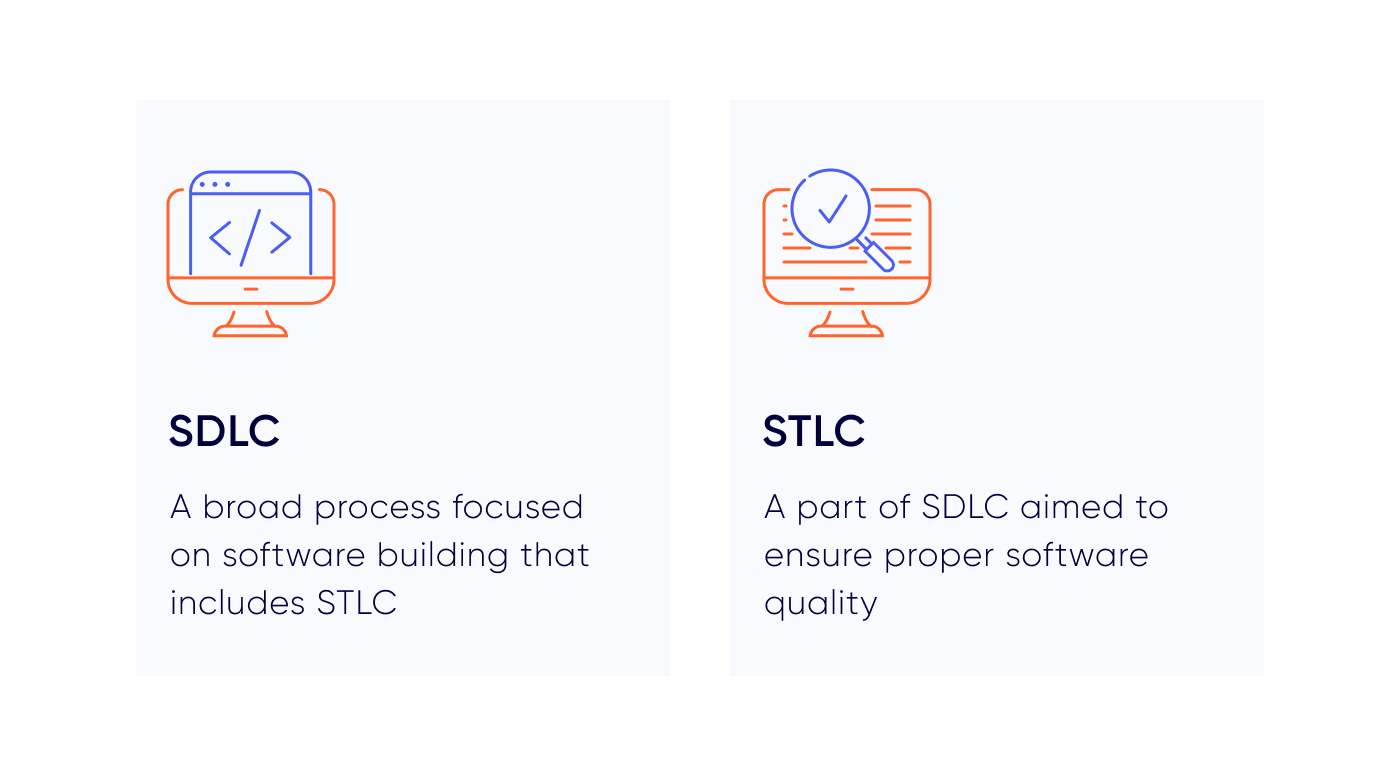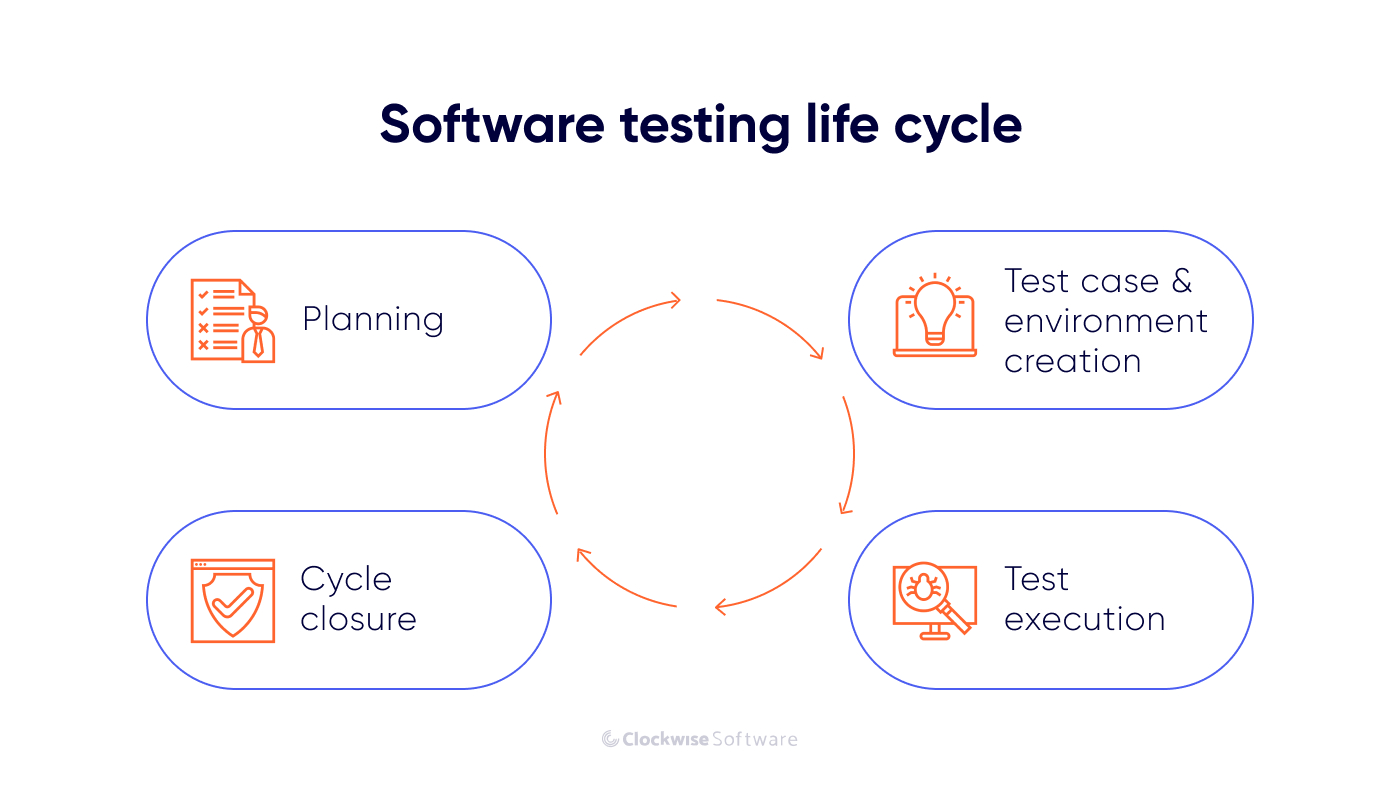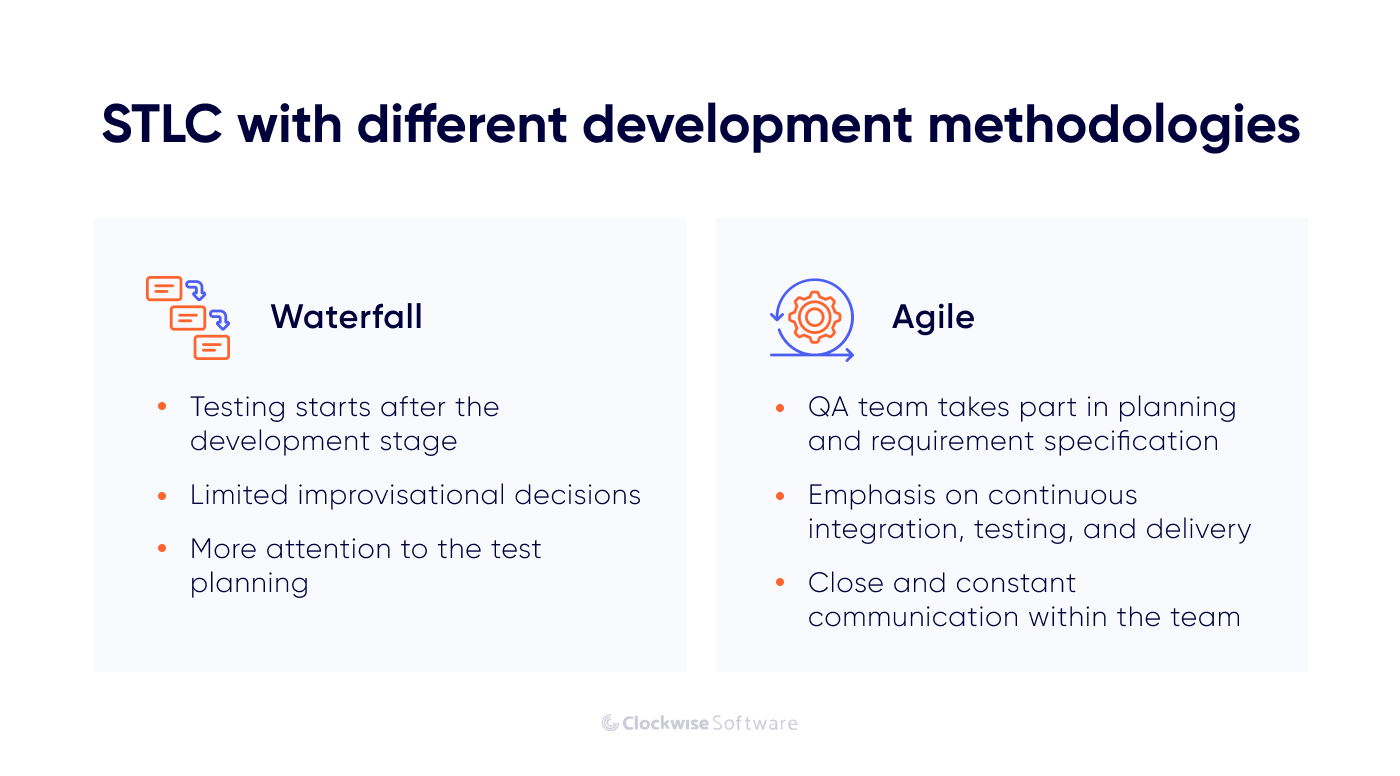What we do
Services
Experts in
Testing is more complicated and important than it might seem at first glance. The software testing lifecycle (STLC) is an all-encompassing approach that guarantees meaningful and efficient software testing throughout development. In this guide, you’ll learn what the software testing lifecycle is, its components, and alternatives. We also explain why this time-consuming and laborious approach is an integral part of the software development process. In addition, we share our expertise on choosing STLC models, overcoming potential challenges, and organizing testing activities.
The term software development lifecycle (SDLC) describes the entire development process. However, it differs significantly from the software testing lifecycle, or STLC. To avoid confusion, let’s explore in detail how they differ and overlap.
The software development lifecycle is a way of organizing all stages of product creation, from building an MVP to expanding the product after release. A typical SDLC includes the following stages:
The software testing lifecycle (STLC) defines a set of steps for product testing. It helps to check if a product is scalable, functions properly, and has top-notch performance. It also helps to reduce bugs before deployment. To put it another way, the SDLC spans all software development processes, while the STLC spans only those related to software testing, such as forming test requirements, designing test cases, and evaluating test results.
A key point to remember is that the software testing lifecycle begins not after development but at the planning and requirements gathering stage. In this way, quality management can be well-planned and structured, and as a result, you can eliminate issues at the start of development and save money and resources on solving them. In the same way, the software testing lifecycle (STLC) doesn’t end after the release. It continues during the maintenance stage, ensuring the proper functioning of the software after new features are released, bugs are fixed, or the codebase is changed.

Now, let’s talk about who exactly is involved in the testing process. Everyone who is somehow involved or has an interest in a project and its success is called a stakeholder. Stakeholders participate in different stages of software development, ensuring a software product’s quality and alignment with business objectives and goals. And their role in defining and executing the STLC is crucial.
What specialists should you involve in testing your software? The composition of stakeholders may vary depending on your software development team structure, but typically the following roles are involved in the STLC:
This is a typical list of stakeholders. In some cases, there may be additional specialists. For example, in healthcare or real estate projects, legal specialists may get involved. They can help prioritize specific functions to check for regulatory compliance. Likewise, when developing FinTech products (which always require security specialists’ involvement), it’s essential to control risks related to securing sensitive data.
The STLC is divided into stages that guarantee the software works great. Though peculiarities of the development process may affect the lifecycle of software testing, each project goes through the following stages:

Let’s analyze each stage, including what it includes, how it works, what pitfalls can appear during the STLC, and how to handle them to get the best outcome.
The testing lifecycle begins with identifying key testing criteria that coincides with the start of the software requirements specification (SRS) stage of the SDLC. What criteria should you establish for testing? It’s common to divide requirements for different testing phases into entry criteria and exit criteria.
Entry criteria encompass all specifications for creating the test environment. This type of criteria is based on business requirements analysis to understand the essential steps to prepare a proper test environment.
Exit criteria, in turn, describe what requirements must be met for a particular testing phase to be considered complete. These criteria may include the following:
This stage helps to avoid ambiguities or inconsistencies in documentation and gain a clear understanding of what needs to be tested and the desired result of each testing phase.
Once you understand the entry criteria and exit criteria of your test cycle, it’s time for the planning stage. At this stage, it’s critical to consider different aspects of a test: namely, to prepare required devices and tools, gather a team of specialists with the right skills, estimate the scope of work, and determine timelines.
To develop a well-thought-out STLC that meets all requirements formed during the previous stage, you need to take the following steps:
Assess the scope of work, taking into account key requirements formed in the previous stage to ensure it’s possible to meet the project deadlines and budget.
Define testing objectives. Clearly defined objectives for the testing process serve as benchmarks to evaluate software quality and effectiveness. They typically include finding defects, ensuring functionality, assessing performance, ensuring security, and enhancing usability. By defining testing objectives, the team can align their efforts and focus on specific areas to achieve desired outcomes during the testing phase.
Choose testing techniques according to project specifics. For example, performance testing may not be critical for custom CRM systems with a limited and precisely known number of users (such as for charter airlines or small logistics companies), but it’s crucial for e-commerce, financial, or gaming apps that work with massive amounts of data and handle multiple user activities.
For example, here are some techniques that we frequently use in our projects:
Consider automation. Test automation offers a lot of benefits, including the following:
However, automation also has some challenges and features you should take into account:
The decision to use automation or manual techniques in the STLC depends on factors such as project requirements, the budget, time constraints, and the nature of the testing being performed.
In our experience, automation is not a universal solution for all projects. Automated tests aren’t the only possible choice for an MVP but are extremely useful after the product’s release when the team is mainly focused on improving the product, making updates, and resolving issues. In this case, test automation will save time and reduce human errors.
A combination of manual and automated testing often provides the best possible outcome.
Select testing tools and infrastructure. These include tools for management (Jira, TestRail, Zephyr), automated testing (Selenium, Postman, Jenkins, Travis CI, BrowserStack, Appium, JUnit, TestNG, Cucumber), performance testing (Apache JMeter, LoadRunner, Gatling), and other use cases.
The test case and environment creation stage is frequently described as one stage in the STLC, but it’s better to divide it into two stages, as developing test cases and creating the test environment are two independent processes with their own specifics. Let’s first take a look at the test case development, or test design, stage.
This stage is all about creating the necessary infrastructure and specifying and prioritizing each test activity. In this way, you can ensure accurate and relevant results and make sure they are clear for the entire development team. The sequential steps you need to take are:
These are must-have components of the test design stage. You can adjust this stage to your needs using a standardized format for test cases, which will simplify their review and execution.
The next stage involves setting up the proper test environment. This involves recreating the product’s operating environment, which includes hardware, software, and network configurations. A test environment may include specific devices, protocols, IP addresses, web addresses, gateways, operating system versions, and security barriers (firewalls).
It’s also essential to select visualization tools like Docker, Vagrant, and VirtualBox. They make it easier for you to store all essential dependencies, configurations, and software versions for the test environment, and, as a result, reproduce the test environment across different devices and servers without problems.
One more thing to do at this stage is smoke testing, which is a group of tests that rapidly check basic software capabilities. Smoke testing aims to determine if software is stable enough to proceed with further testing. With smoke testing, you can detect major bugs early and avoid wasting resources on checking unstable software.
When all the preparatory work is done and test engineers receive a stable version of the app, the core software testing lifecycle (STLC) stage — test execution — starts. We can divide this stage into the following steps:
To optimize resources, you can prioritize defects based on their severity and impact and conduct root cause examination for critical defects.
After test execution, it’s time to report defects. All negative test results recorded during the test in the defect tracking system should be reported to the development team. To make it easier for developers to fix existing defects, you need to create a defect report, which describes all existing errors and bugs and mentions the desired outcome after fixes. Once developers manage the defects, your test team should perform another test to detect if the errors have been fixed.
To finish the STLC, it’s necessary to save and analyze the results of previous stages. One of the last stages, test cycle closure, includes the following steps:
Finally, the last step of the software testing lifecycle is evaluating test results. Information in the summary reports prepared during the previous stage serves as a guide for further improvements. Evaluating results involves analyzing test data and metrics to understand if test objectives have been met and to understand what types of defects occurred most often during testing.
This step is critical to assess the effectiveness of testing and identify what needs further improvements. Once a test is evaluated and all necessary fixes have been made and checked, the QA team presents a closure report for stakeholders and obtains sign-off from them.
We have considered all software testing lifecycle stages, their main components, tools, and software required for testing, and ways to achieve better results. Next, we take a look at how different approaches to software development can influence the STLC.
The STLC has a defined set of stages applicable to all projects. However, how they are implemented may vary depending on the development methodology, namely Agile or Waterfall. We can also call these methodologies of the software testing lifecycle in this context.
Let’s take a closer look at two popular models — Waterfall and Agile — to understand their impact on test cycle organization.
The Waterfall model involves phased development, meaning each stage follows a specific sequence. Once a certain phase is completed, development moves to the next phase, and there is little to no room for going back to a previous phase. This means the following for the STLC process:
This model may limit flexibility due to extensive documentation and a structured approach. However, its advantage is a well-organized and documented testing process. That’s why Waterfall is suitable for small projects that have fixed requirements.
The Agile app development model is an iterative and incremental approach to software development. The entire scope of work is divided into milestones, each of which is achieved through a series of sprints. Each sprint goes through planning, execution, analysis, and error correction. It involves close collaboration within the team and provides great adaptability to changes at any stage of development. Agile allows you to shorten your development time and reduce risks.
The Agile software testing lifecycle is characterized by the following:
Just like the Waterfall methodology, Agile has its challenges. The first is the need for close and constant communication, which can be a problem if you hire dedicated developers without sufficient expertise. Therefore, it’s worth carefully weighing outsourcing benefits and risks. Second, flexibility frequently becomes a disadvantage for projects with a high level of regulatory compliance requirements. Such projects can benefit from a more structured approach like the Waterfall model provides.
As you can see, the choice of software testing lifecycle model is determined by features of the development process. To choose the best one for your project, you should closely analyze available models.

You can use software development consulting from an experienced discovery team to get missing technical knowledge, estimates, and useful recommendations based on real development experience.
Any project involves testing and fixing bugs in one way or another. However, not all teams use a software testing lifecycle. At first glance, doing so may seem too expensive and laborious. This encourages teams to consider alternative testing approaches to reduce cost and effort.
Using ad-hoc testing as an independent method is usually mentioned as an alternative to an STLC. This model, also known as random or monkey testing, is an informal approach involving unstructured and unplanned inspection. It can be helpful for detecting critical defects and can be included in an STLC. However, as an independent method, it does not guarantee usability, excellent performance, and overall product quality.
Using testing techniques without following an STLC or opting for alternative methods may initially seem easier. However, it can complicate development and have negative consequences for your software in several aspects:

As you can see, using a software development lifecycle has significant advantages. That is why it is a widespread and generally recognized practice.
It’s worth noting that these benefits apply not only to in-house development teams. They are also relevant if you outsource web development services.
Outsourcing partners who follow an STLC can provide better communication, more effective testing, and improved overall software quality, resulting in a positive experience for both you and your customers.
Let’s demonstrate this with a real case. We have experience working with clients who initially did not consider applying STLC practices to their project — a chess simulator. The app owners thought that the testing process would be simple and that quality assurance specialists wouldn’t be able to evaluate and test the product better than experienced chess players. At first glance, it might seem they were right to hold off.
However, critical questions about aspects of development and testing (voiced by our specialists during the planning process) along with detailed descriptions of proposed evaluation criteria ultimately convinced the client that a comprehensive approach was needed to ensure the game’s quality.
By working with an STLC, the team was able to compile clear documentation, plan test cases covering all important aspects of testing and development, and address possible flaws in the design that were missed during previous development stages.
As a result, the initially skeptical clients recognized the undeniable benefits of using an STLC. You can leverage consulting services to analyze your business idea and assess your testing process. Our experienced team can give you valuable insights into how the software testing lifecycle can benefit your idea and which practices are worth using for your project.
The software testing lifecycle (STLC) serves as a crucial framework for ensuring the quality, functionality, and performance of software products. It enables comprehensive test coverage, early bug detection, and efficient issue resolution.
Throughout this guide, we explored key components of the STLC, including test requirements, test planning, test execution, defect management, and test closure. We also examined how the STLC integrates with different software development methodologies, such as Waterfall and Agile, highlighting their impact on test cycle organization.
Whether you are developing software in-house or outsourcing web development services, it’s better to choose a software development partner that adopts STLC principles, as it leads to improved software quality, reduced risks, and enhanced customer satisfaction.
By prioritizing quality assurance all the time when developing software and using information and tips from this guide, you can create robust, reliable, and user-centric software solutions.
